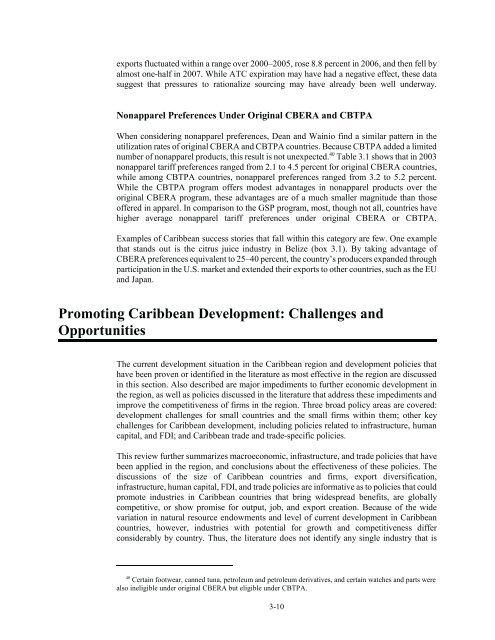Caribbean Region: Review of Economic Growth and ... - USITC
Caribbean Region: Review of Economic Growth and ... - USITC
Caribbean Region: Review of Economic Growth and ... - USITC
Create successful ePaper yourself
Turn your PDF publications into a flip-book with our unique Google optimized e-Paper software.
exports fluctuated within a range over 2000–2005, rose 8.8 percent in 2006, <strong>and</strong> then fell byalmost one-half in 2007. While ATC expiration may have had a negative effect, these datasuggest that pressures to rationalize sourcing may have already been well underway.Nonapparel Preferences Under Original CBERA <strong>and</strong> CBTPAWhen considering nonapparel preferences, Dean <strong>and</strong> Wainio find a similar pattern in theutilization rates <strong>of</strong> original CBERA <strong>and</strong> CBTPA countries. Because CBTPA added a limitednumber <strong>of</strong> nonapparel products, this result is not unexpected. 40 Table 3.1 shows that in 2003nonapparel tariff preferences ranged from 2.1 to 4.5 percent for original CBERA countries,while among CBTPA countries, nonapparel preferences ranged from 3.2 to 5.2 percent.While the CBTPA program <strong>of</strong>fers modest advantages in nonapparel products over theoriginal CBERA program, these advantages are <strong>of</strong> a much smaller magnitude than those<strong>of</strong>fered in apparel. In comparison to the GSP program, most, though not all, countries havehigher average nonapparel tariff preferences under original CBERA or CBTPA.Examples <strong>of</strong> <strong>Caribbean</strong> success stories that fall within this category are few. One examplethat st<strong>and</strong>s out is the citrus juice industry in Belize (box 3.1). By taking advantage <strong>of</strong>CBERA preferences equivalent to 25–40 percent, the country’s producers exp<strong>and</strong>ed throughparticipation in the U.S. market <strong>and</strong> extended their exports to other countries, such as the EU<strong>and</strong> Japan.Promoting <strong>Caribbean</strong> Development: Challenges <strong>and</strong>OpportunitiesThe current development situation in the <strong>Caribbean</strong> region <strong>and</strong> development policies thathave been proven or identified in the literature as most effective in the region are discussedin this section. Also described are major impediments to further economic development inthe region, as well as policies discussed in the literature that address these impediments <strong>and</strong>improve the competitiveness <strong>of</strong> firms in the region. Three broad policy areas are covered:development challenges for small countries <strong>and</strong> the small firms within them; other keychallenges for <strong>Caribbean</strong> development, including policies related to infrastructure, humancapital, <strong>and</strong> FDI; <strong>and</strong> <strong>Caribbean</strong> trade <strong>and</strong> trade-specific policies.This review further summarizes macroeconomic, infrastructure, <strong>and</strong> trade policies that havebeen applied in the region, <strong>and</strong> conclusions about the effectiveness <strong>of</strong> these policies. Thediscussions <strong>of</strong> the size <strong>of</strong> <strong>Caribbean</strong> countries <strong>and</strong> firms, export diversification,infrastructure, human capital, FDI, <strong>and</strong> trade policies are informative as to policies that couldpromote industries in <strong>Caribbean</strong> countries that bring widespread benefits, are globallycompetitive, or show promise for output, job, <strong>and</strong> export creation. Because <strong>of</strong> the widevariation in natural resource endowments <strong>and</strong> level <strong>of</strong> current development in <strong>Caribbean</strong>countries, however, industries with potential for growth <strong>and</strong> competitiveness differconsiderably by country. Thus, the literature does not identify any single industry that is40Certain footwear, canned tuna, petroleum <strong>and</strong> petroleum derivatives, <strong>and</strong> certain watches <strong>and</strong> parts werealso ineligible under original CBERA but eligible under CBTPA.3-10
















